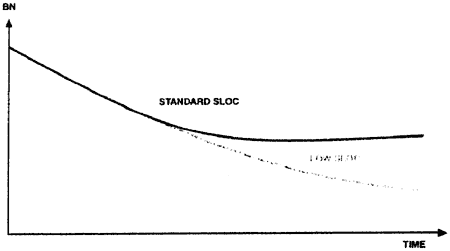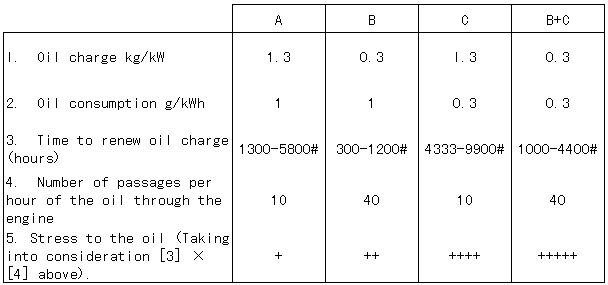For example if one checks the BN of oil for HFO burning engine, the topping-up may not be sufficient to maintain the oil at sufficiently acceptable BN level. In such cases it needs higher BN type lubricant, or shorter oil drain/change intervals (see Fig. 6c).

Fig. 6c - Typical evolution curve.
In case of a fairly large dry-sump at 1.3 kg/kW in conjunction with a low specific lube oil consumption of 0.3 g/kW.h, the theoretical time to renew the whole charge is about 4333-9900 hours (based on a 4000 kg oil charge for a 3077 kW engine). In comparison to the above [Dry-sump, Reasonable Oil Consumption] it is obvious that the oil-in-use will suffer much more under condition of low oil consumption - i.e. compare Case A versus C in Table 7 below.
Low Oil Consumption and Small Oil Charge.
The situation becomes even worse in the case of wet-sump (small oil charge) with a very low oil consumption (see Fig. 6d). Using the example engine again (0.3 kg/kW oil charge; 0.3 g/kWh consumption rate; 12 kg/kWh flow), the oil renewal rate now becomes 1000-4400 hours, but the oil is subjected to higher number of working cycles/passes (40 passes per hour) through the engine.

Fig. 6d - Typical evolution curve.
The above are provoking thoughts contributed by this specific paper. The actual bulletin avoids the controversy of limiting what is considered low or high oil consumption; whether the oil consumption is considered too low is factor or consideration specific to each engine design and it depends on their respective needs. The bulletin is now published as CIMAC Recommendation n° 17 entitled "Guidelines for diesel engines lubrication" "Oil consumption of medium speed diesel engines". It identifies factors that influence oil consumption; it then clarifies what happens to oil parameters and their consequences when oil consumption becomes low and impact the oil and engine operation, and it gives caution and advice to consider.
Table 7 gives a summary of above with oil stress ranking.

A = Typical
B = Low oil charge
C = Low oil consumption
B + C = Low oil charge and low oil consumption
# = time to reach a 99% renewal when considering both fresh and original aged oil consumed together after each top up.
BACK CONTENTS NEXT